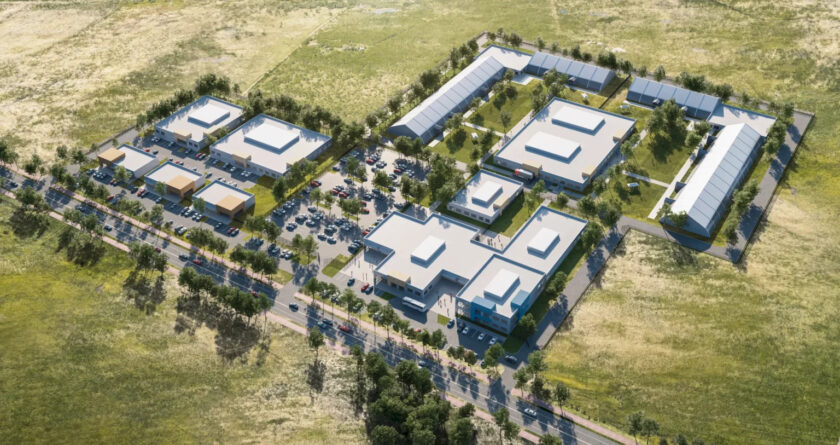Utah’s new homeless campus should have 300-plus beds for civil commitment, board chair says

Courtesy the Utah Office of Homeless Services
A conceptual rendering depicts what state leaders envision for a new “transformative campus” meant to house and rehabilitate people experiencing homelessness.As the vision for a new, 1,300-bed homeless “campus” recently sited in northwest Salt Lake City begins to crystalize, a discussion in front of a panel of lawmakers this week showed that the state’s top homeless services leaders see it as a key component to the state’s response to President Donald Trump’s July controversial executive order titled “Ending Crime and Disorder on America’s Streets.”
To do so, they’re proposing the campus not only include additional homeless shelter, but also hundreds more beds to expand the state’s capacity for involuntary civil commitment and drug addiction treatment.
Under a yet-to-be-approved proposal drafted by Randy Shumway, chair of the Utah Homeless Services Board, the campus would include a “certified community behavioral health clinic” with 300 to 400 beds reserved for people who are civilly committed — or court ordered into mental health treatment.
Shumway’s proposal also envisions the campus including a “secure residential placement facility that provides substance use disorder treatment as an alternative to jail,” where people would “receive care in a supervised environment where entry and exit are not voluntary.” He called it an “accountability center” during a presentation in front of the Health and Human Services Interim Committee on Tuesday.
“An individual would be sanctioned to go there. It would not be voluntary. They would be there for a period of probably 90 days with the opportunity to detox in order to get mental and behavioral health care, to get substance use disorder support, to get physical health care, and to be surrounded by a community that’s helping them in healing,” Shumway told the committee while presenting his proposal.
Shumway’s proposal is his recommended action plan to align the state with Trump’s executive order — something he said he “wrote at the request” of the state’s top Republican leaders. He emphasized that it hasn’t been presented to or approved by the Utah Homeless Services Board, which is a powerful body that oversees the state’s homeless system and distributes funding to homeless providers.
On July 29, five days after Trump’s executive order on homelessness, Utah House Speaker Mike Schultz, Senate President Stuart Adams and Gov. Spencer Cox wrote a letter urging the Utah Homeless Services Board to act, including by accelerating “progress on a transformative, services-based homeless campus that prioritizes recovery, treatment, and long-term outcomes, not just emergency shelter.”
Advocacy groups like the National Alliance to End Homelessness have condemned Trump’s executive order. They warn it imposes “a multitude of harmful, ineffective, and outdated policies and practices for addressing homelessness” while retreating from long-maintained federal “Housing First” strategies that prioritize federal funding to programs that provide immediate housing.
They also worry it will also increase focus on “punishing” people experiencing homelessness by encouraging states and cities to more widely arrest people on the streets and expand their use of civil commitment to force people into mental health or drug addiction treatment.
Republican leaders of Utah, however, have warmly welcomed Trump’s executive order as aligned with their goal to make the state’s homeless system more “accountable” while emphasizing efforts to increase “public safety” on city streets.
Cox, Schultz and Adams wrote that Trump’s executive order “aligns with the values and expectations that Utah has long championed, namely, that chronic homelessness is tied to mental illness, substance abuse, and the loss of human dignity.” They also wrote they “do not support ‘Housing First’ policies that lack accountability.”
“President Trump’s executive order reinforces what many of us in Utah have long understood: that effective solutions to homelessness require both accountability and support,” Cox, Schultz and Adams wrote, adding that the order “presents an opportunity to accelerate our efforts toward a more results-driven system that matches Utah’s guiding principles to end homelessness” that “emphasize comprehensive, wrap-around services anchored in real accountability and community-based support.”
They also directed the board to “ensure any funding requests are accompanied by a clear strategy that aligns with the President’s executive order, with a focus on reprioritizing existing resources.”
Mental health, other services already underfunded
During Tuesday’s committee discussion, both a Democratic and Republican lawmaker pointed out that the state’s existing system, including mental health treatment, has long been underfunded.
“I wonder if it’s not necessarily inefficiencies but underinvestment in the infrastructure that we do have,” said Rep. Jen Dailey-Provost, D-Salt Lake City.
Dailey-Provost added that she’s “concerned” about building a homeless campus in a remote area of Salt Lake City that’s “far away from the services and infrastructure that we do have — that we’ve designated as not being successful, but not because the infrastructure isn’t correct but because we’ve underinvested in it.”
“If we’re going to be efficient, I want to make sure we’re having a really hard conversation about investing in infrastructure that we have built, that we know works if it’s properly invested in,” she said.
Rep. Steve Eliason, R-Sandy — a lawmaker who has a long track record of passing legislation related to homelessness, mental health and civil commitment — also hearkened back to his comments in front of the Utah Homeless Services Board more than a year ago, when he warned the state has been facing a major shortage of mental health beds.
That shortage remains acute today, and even if the state homeless campus is built to accommodate 300 or 400 more civil commitment beds, there would still be hundreds more lacking, barring a major expansion elsewhere in the system.
“As of a few days ago we had 1,461 individuals in the state on civil commitment,” Eliason said, noting that about 220 of those are in the Utah State Hospital, plus “maybe several dozen” in other mental health facilities.
“That probably leaves at least 1,000 people currently under civil commitment on the streets,” he said. “So while I don’t disagree that applying civil commitment is a critical tool, currently our system is completely overwhelmed where people that are on civil commitment are not, in the vast majority of cases, receiving inpatient services. So that’s something we have to work on.”
Shumway, in response to Eliason’s comments, pointed to a line in his proposal that says the 300 to 400 civil commitment beds would be federally funded with reimbursed Medicaid dollars. He said “we’re in close collaboration” with the U.S. Department of Housing and Urban Development on the proposal.
“We’ve got to come to the rescue from a mental and behavioral health care standpoint,” Shumway said.
Eliason said he “appreciated” Shumway’s comments, but “unfortunately if you look at the history of recent construction of psychiatric facilities in the state … inpatient beds are running about a million dollars a bed, just to be built to the standards that the federal government has required.”
“So it’s a huge price tag,” Eliason said.
Shumway’s proposal, however, said that under Trump’s executive order, “every federal housing, health and justice agency is instructed to link grants, waivers, and personnel to states that are investing in effective practices,” including opening “more in-patient psychiatric beds” and launching “jail-based competency-restoration units.”
But Senate Minority Leader Luz Escamilla, D-Salt Lake City — who was critical of the homeless campus being sited in west-side Salt Lake City — noted “there’s already a bunch of lawsuits” challenging Trump’s executive order.
She urged Shumway to “engage with everyone” in the Legislature while formulating next steps.
“Because it will require not only the funding of the Legislature, but also policies,” she said. “I mean, we’re going to have to change laws, and a lot of these are policy calls.”
A low-income advocate’s concerns
Bill Tibbitts, deputy executive director of Crossroads Urban Center, a low-income advocacy nonprofit based in Utah, raised a slew of concerns about Shumway’s proposal in an email to Utah News Dispatch on Tuesday.
While state officials have said they expect the campus’ infrastructure to cost about $75 million — plus north of $30 million a year for ongoing operations — Tibbitts said what’s being proposed will likely need much more.
“The cost of building a second state mental hospital, a large substance use treatment facility, and a shelter with 600 -1,300 beds will be much higher than $75 million,” Tibbitts said in his email, adding that it sounds like it could be even more expensive than Salt Lake County leaders’ failed proposal to use a $507 million bond to fix the county’s jail crisis.
Tibbitts also worried about a possible chilling effect by building a civil commitment facility in proximity to homeless shelter beds.
“A 300-400 bed mental and behavioral health facility that people are not allowed to leave is not a shelter but an incarceration option,” Tibbitts wrote. “Having such a facility colocated with a shelter would probably lead to a sense that if you do not follow the rules in one facility you could be moved into the other.”
Tibbitts said Shumway’s presentation made it sound like services at the homeless campus would entail “a law enforcement presence at the shelter and an involuntary detention center for people unable to follow the rules.”
“Would wandering away from the shelter without permission be something that gets you placed in the detention center? If so, how long before it is completely full?” Tibbitts questioned.
Tibbitts also said it’s “worrisome” that the campus is envisioned to be a “regional entry point for homeless services.”
“A senior citizen who had their rent increased beyond what they could afford is not going to want to go to a quasi correctional facility to get help finding a place to live that they can afford,” Tibbitts said. “The majority of the people who visit a shelter are not chronically homeless — they just need a place to stay following a short term period of financial hardship.”
During Tuesday’s presentation, both Shumway and state homeless coordinator Wayne Niederhauser emphasized that they envision Utah’s system helping move people along a “pathway” of rehabilitation and recovery and more efficiently placing people where they need to be in order to succeed.
In response to a request for an interview about his comments during Tuesday’s meeting, Shumway declined, telling Utah News Dispatch in a text message that what he shared was “simply my vision and hasn’t yet been presented to the full (Utah Homeless Services Board).”
“We’re still very much in the early planning stages, so it’s a bit premature for a detailed conversation,” Shumway said. “Once we’re further along, I’d be happy to share more.”
Asked whether what’s being proposed could be characterized as a “homeless jail” or something similar, Shumway said the envisioned “accountability center” is focused on “recovery, healing and reintegration.”
“Participants receive a full suite of wraparound services, including mental and behavioral health care, physical healthcare, substance use disorder treatment, counseling, and education,” Shumway said. “The goal is simple: to break the cycle of crisis. By addressing root causes, reducing recidivism, and saving lives, an Accountability Center offers a better path forward — an investment in people’s recovery and in stronger, safer communities.”
Utah News Dispatch is part of States Newsroom, the nation’s largest state-focused nonprofit news organization.



